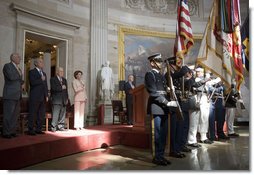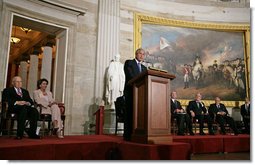
 |
For Immediate Release
Office of the Press Secretary
July 17, 2007
President Bush Presents Congressional Gold Medal to Dr. Norman Borlaug
United States Capitol
10:53 A.M. EDT
THE PRESIDENT: Thank you, all. Madame Speaker, thank you. Madame Speaker, Mr. Leader, members of the congressional leadership, members of the Iowa delegation, fighting Texas A&M Aggies, Dr. Borlaug and his family:
All around us are testaments to our republic's young and storied history. Yet sometimes it takes a ceremony like this to remind us what a special place America is.
 Ours is a land of hope and promise and compassion. And we see that
compassion and promise in the man we honor today -- a farm boy, educated in
a one-room schoolhouse, who left the golden fields of Iowa to become known
as "The man who fed the world."
Ours is a land of hope and promise and compassion. And we see that
compassion and promise in the man we honor today -- a farm boy, educated in
a one-room schoolhouse, who left the golden fields of Iowa to become known
as "The man who fed the world."
Many have highlighted Norman Borlaug's achievements in turning ordinary staples such as wheat and rice into miracles that brought hope to millions. I particularly appreciated the story about a former Vice President, and fellow Iowan, named Henry Wallace, who once came to observe Norman's grain experiments up close. The Vice President looked around, and then asked why a good Iowa boy like Norman wasn't working on something to do with corn. (Laughter.)
Norman Borlaug's life has taken him from laboratories in America and Mexico to dusty villages throughout the developing world. He has consulted with presidents and prime ministers in important countries like Pakistan and India. He's helped inspire students at Texas A&M, where an institute bearing his name is dedicated to completing his life's work. To this day Norman leads an active life -- listen to a friend, who said that Norman spends half his year in Texas, half his year in Mexico -- and the other half wherever else he's needed. (Laughter.) That is interesting math. I was going to say that I bet some of us wish we could use that kind of math during the budget process here in the Capitol. (Laughter.) I'm afraid sometimes we do.
What that friend meant was that Norman Borlaug has lived his life with urgency. He has long understood that one of the greatest threats to global progress is the torment of human hunger. And we've seen that plague haunt history many times. Famine in the mid-1800s forced hundreds of thousands of Irish citizens to take a sad and desperate journey to America -- and turned the Atlantic Ocean into what an Irish poet called "a bowl of bitter tears." More than a century later, wrenching images of emaciated children in Ethiopia rallied the world to the tragedy of famine. Hunger continues to cast its miserable shadow across much of the developing world -- robbing villages of children, and forcing human beings to make desperate and daily searches for food and clean water.
Wealthy and prosperous nations have a moral obligation to help poor and struggling people find their own paths to progress and plenty. To whom much is given, much is required, and we've been given a lot here in America. It's the calling of our conscience, and it's a compelling national interest. A quote that Dr. Borlaug made reference to when he received the Nobel Prize says it well: "You can't build peace on empty stomachs."
 In the past half-century, we have seen a glimpse of the world that is yet
to come. Since the end of the World War II, the advance of trade and
technology has lifted hundreds of millions of people out of poverty.
That's really the triumph of human liberty stretching across natural
boundaries. It is a tribute to innovation and entrepreneurship. And these
are the characteristics that can be found in the very best of our citizens,
such as the man we honor today.
In the past half-century, we have seen a glimpse of the world that is yet
to come. Since the end of the World War II, the advance of trade and
technology has lifted hundreds of millions of people out of poverty.
That's really the triumph of human liberty stretching across natural
boundaries. It is a tribute to innovation and entrepreneurship. And these
are the characteristics that can be found in the very best of our citizens,
such as the man we honor today.
When Dr. Borlaug received the Presidential Medal of Freedom from one of my predecessors, Gerald Ford, the citation noted that Norman's work "has pushed back the shadow of hunger on this planet and given us precious time to force its final retreat." That final retreat will come only as long as we hold in our hearts the revolutionary spirit of men like Norman Borlaug, whose Green Revolution brought hope to troubled corners of the world, where grateful villagers still praise his name.
The most fitting tribute we can offer this good man is to renew ourselves to his life's work, and lead a second Green Revolution that feeds the world, and today we'll make a pledge to do so.
Dr. Borlaug, I thank you for your vision and dedication. I thank you for leading a life of great purpose and achievement. I thank you for proving to Americans that what we learned as children is true, that one human being can change the world. May God bless you, sir. May God continue to bless our wonderful country.
And now I ask the Speaker and Senator Reid to join me for the Gold Medal Presentation.
(The Congressional Gold Medal is presented.) (Applause.)